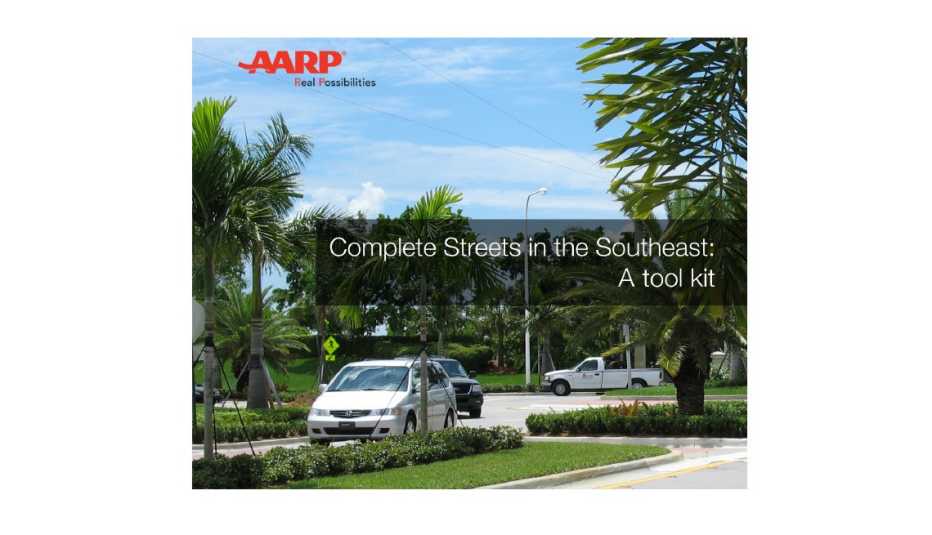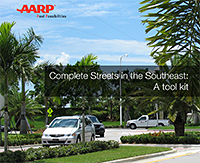AARP Hearing Center


Of the more than 600 Complete Streets projects in place across the U.S., almost 20 percent can be found in the Southeast states of Alabama, Arkansas, Florida, Georgia, Louisiana, Mississippi, North Carolina, South Carolina and, last but not least, Tennessee.


The Complete Streets in the Southeast tool kit is a partnership between AARP Government Affairs, Smart Growth America and the National Complete Streets Coalition based on the implementation of Complete Streets programs in several southern communities.
AARP’s interest in Complete Street policies is both broad and focused: “Central to the creation of livable communities is the possibility for everyone, regardless of age or ability, to travel safely. Yet, many of our nation’s roads do little to meet the needs of the growing population of older Americans. The U.S. Census Bureau projects that by 2025 nearly one in five Americans, or 62 million Americans, will be over the age of 65. While many of these older adults will continue to drive, some will seek other transportation options and find them lacking.”
Key Points
The tool kit is both a research report and how-to guide.
After providing an overview of Complete Streets, which the authors explain “is shorthand for approaching transportation decisions with the intent to provide safe, comfortable and convenient options for travel by all modes — walking, bicycling, driving and taking public transportation — and by all users, regardless of age, ability, income, race or ethnicity,” the tool kit walks readers through some important first steps.
For instance, groups working to achieve Complete Streets can best find success by first “building support for Complete Streets” and then effectively “communicating the Complete Streets message” to community leaders, local transportation officials and engineers, business people, residents and the media.
(Among the points to make: “Complete Streets are safe streets," and walkable and bikeable neighborhoods are good for local economies.” Among the implementation goals to set are those that can be achieved immediately so all involved experience some quick wins; reaching most goals will likely be mid- to long-term undertakings.)
After that, “focus must shift to the inner workings” of the community’s transportation agency. Groups and individuals implementing Complete Streets need to have a complete understanding of a community’s existing processes, procedures and design documents. This stage of the work requires a deep document dig, an assessment of what’s found, educational outreach and diplomacy in order to effectively toss out the old and bring in the new.
“Process changes will be the most successful if the overarching Complete Streets goals are clear when developing the policy and if transportation staff members have embraced the new goals,” the authors write. “Implementing Complete Streets successfully requires inclusive decision-making processes.”
Fact Sheets and Case Studies
Of significant value and interest are the tool kit’s six case studies and nine state-specific fact sheets. The case studies report about Complete Streets efforts in Birmingham, Ala.; Broward County, Fla.; Decatur, Ga.; New Orleans, La.; Greenville, S.C.; and Memphis, Tenn. Each write-up ends with a “lessons-learned” conclusion.”
Excerpts from (and links to) a Complete Streets implementation plan from Cobb County, Ga., provide similar real-place examples. Also included is a six-step decision-making process model from Charlotte, N.C., and worksheets for replicating the steps elsewhere.
Complete Streets-related fact sheets are included about Alabama, Arkansas, Florida, Georgia, Louisiana, Mississippi, North Carolina, South Carolina and Tennessee.
An interesting fact sheet fact: According to Transportation for America’s Dangerous by Design 2011, Florida is “the single most dangerous state to walk in.” On the positive side, Fort Lauderdale, Fla., and the Tampa area’s Hillsborough County, Fla., receive kudos, along with Birmingham, Ala., for having “exemplary” Complete Streets policies.
Other valuable assets in the tool kit include:
- Links to videos and presentations, including to an introductory, template presentation about Complete Streets
- Sample letters to the editor and editorials
- A template for a Complete Streets audit and implementation plan
- Questions to ask and worksheets to use when evaluating existing documents and procedures (e.g. how do the policies address the needs of people walking, bicycling and driving?)
How to Use
The Complete Streets in the Southeast tool kit provides resources and tools for effectively achieving the adoption and implementation of Complete Streets — regardless of whether the community in question is in the east, west, north, south or southeast.
Download the Report
Learn More About Complete Streets
- "Evaluating Complete Streets Projects: A Guide for Practitioners"
- Cobb County Complete Streets Implementation Plan
- Smart Growth America
- AARP Livability Fact Sheet Series
- Dangerous by Design 2014 Report
- Slideshow: Dangerously Incomplete Streets


























































